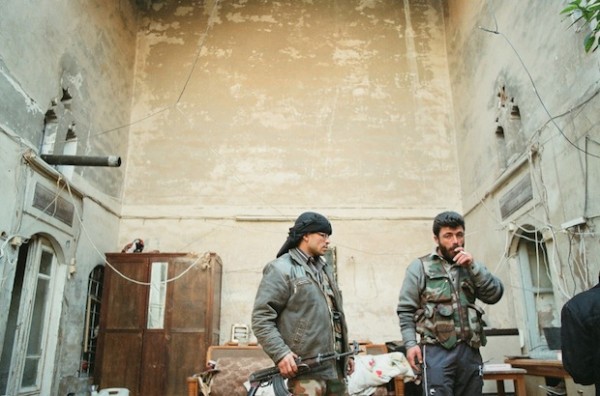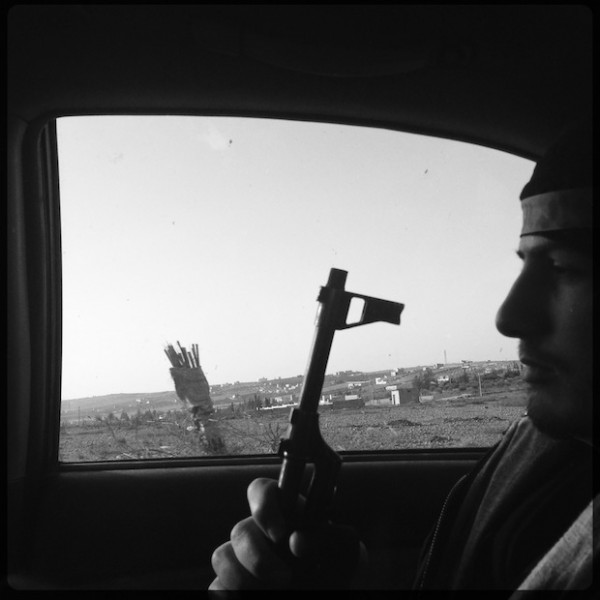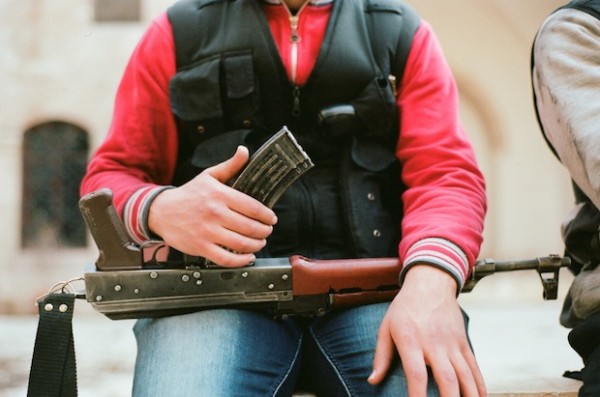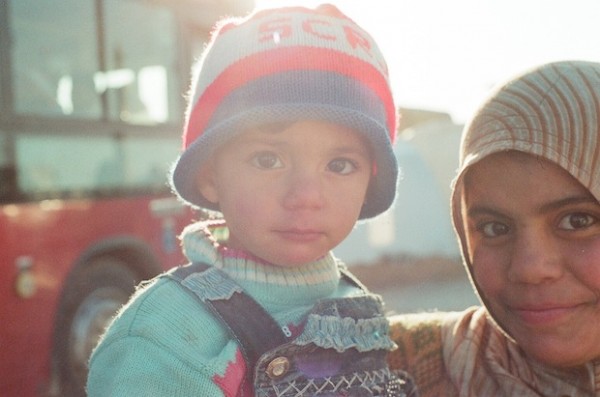It’s cold. The air is stinging my ears and my hands are numb. I pull back on my gloves and resume huddling in the conner of the courtyard. It’s December in Aleppo and the air is bitter, but the overwhelming sense of dread comes not from the cold, but from overhead. Early morning, midday, through the night — the aerial bombardment doesn’t stop. The sound of a jet buzzing overhead and those terrible trails of white streaming from the underbelly as missiles launch. Distant blasts and then closer ones. Mortar strikes as well. Silence and then an explosion.


My Experience Photographing on the Front Lines of the Syrian Civil War
The targets are all unclear and reports of recent attacks on schools and hospitals make it fairly obvious the jets are actively targeting civilians as well as the rebel forces. I’m not likely to get hit with an airstrike this morning, as I’m a building away from government forces and the planes wouldn’t risk hitting their own troops. FSA fighters swirl around and past me. Some are carrying weapons, others shouting. I’m at one of the many front lines of the battle over Aleppo, documenting the Free Syrian Army’s fight for the city.
Machine-gun fire erupts a few yards from me and shell casings scatter to the ground at my feet. The bitter smell of gun powder hangs softly in the air as explosions echo in the background. I’m the only Westerner here and I’m surrounded by young men saying they’re on Jihad. A grenade explodes. Yells of “Allahu Akbar” break through the noise. The gunfire intensifies and I close my eyes. All that’s going through my head is, Did I go too far this time? Why the hell am I here?
I started photographing when I was in high school, and my journey through the medium has taken me from studio photography, to years in Asia, then into documenting social issues, and now conflict. It’s been a winding road, but the medium is essential to the person I am and the stories I want to tell. Personally, I don’t think there’s any better way to explore how I fit into this world while being able to share my experiences and the situations others are facing than through photography. This also means continuing to explore the different forms of photography and how they can be used separately and in unison.
Photographing in a war zone is stressful and challenging. Unlike other forms of photography, where the most important thing is getting the photo, the most important thing in conflict is staying safe. So beyond the gear and settings, there’s finding people you trust, focusing on building relationships that could keep you alive, having insurance, eating the right foods and finding clean water, and avoiding snipers and friendly fire — all while constantly trying to wrap your head around what’s materializing in front of you.
While I was in Syria I primarily shot on my DSLR, because when you shoot news-oriented material you need to be able to upload images quickly. There are deadlines, and if something big happens you need to be able to send the shots off immediately. I also used my Nikon F100 and iPhone. I’ve been shooting on my iPhone since I finally picked one up a few years ago, and it’s completely changed the way I shoot. I love the device, and always having a small camera on me has made a big difference in how often I shoot and the images I’m able to capture.
It can almost make shooting in conflict or disaster zones easier. In situations like the crisis in Syria, not everyone wants their photo taken and situations can turn ill at the sight of a lens, but being able to pull out a small camera like an iPhone and snap a few photos without anyone noticing is an incredible advantage. Because people are less likely to notice an iPhone, you’re also able to keep the situation natural and not create a staged scene by bringing out a bigger-bodied camera — an extremely important factor when documenting a situation.
For example, I was on my way into Aleppo with a brigade of Free Syrian Army fighters I had only just met, crammed in the back seat and sitting next to a young man with a Kalashnikov at his side. I had only been able to say a few words to him before getting in the car and knew very little about his views on journalists or how he felt about being photographed. I also wasn’t sure how much English he spoke from our brief interaction before our ride together to the front lines of a war zone.
He seemed shy but he had a loaded weapon in his hand, and if there’s anything I can say with certainty, it’s respect a man, no matter how young, with a gun. As we drove along the dust-strewn roads of northern Syria with war tunes blaring from the radio, I kept my cameras out of sight. We passed people huddled around oil drums, bread lines, smoke trails rising over towns from recent jet attacks. We drove through makeshift checkpoints where armed men would demand that the car stop so they could peer inside.
It was painfully obvious how chaotic this area of the country had become. The government had lost this part of northern Syria to the Free Syrian Army, who was now fighting to maintain control of it while desperately trying to ensure petrol and food were supplied for the local population — something they were failing at miserably. Because of what was going on outside the car and the fighters I had only just met surrounding me, the only way I could take photos was with my phone, which looked more like I was just checking the time than actually taking a picture.
Shooting film, however, is a long-time love affair of mine and one that I wanted to take advantage of while covering conflict. Not many war photojournalists shoot on film anymore because of deadlines and how easy and advanced digital cameras have become, but I still think the imagery created from film is beautiful and overall makes me pay more attention when I click the shutter.
Most of the time I spent in Aleppo was in darkened alleyways and destroyed buildings near the front lines. Snipers controlled the streets, rooftops, and basically anywhere there was a beam of light. If you thought someone could see you from a distance, they probably could, and they could probably kill you. Because of this, keeping inside and running from building to building quickly was important. The fighters and civilians had created tunnels to get around the city. They’d be unable to go outside to get to the next house or apartment so they’d break through a wall.
I ended up staying with a Free Syrian Army group that was fighting over the Old City of Aleppo. In the center of the Old City sits the medieval Citadel of Aleppo. Its location on a large hill gives it the best view of the entire area and also made it the tallest structure. It also happened to be controlled by Assad’s forces at the time I was there, and they had snipers posted atop the walls overlooking the area I was staying in. If you could see the Citadel, the Citadel could see you, so the last thing I was going to do was be on a rooftop, near a window, or in a street facing the castle on the hill.
Unfortunately, the film I brought with me wasn’t exactly what I should’ve been carrying for the situations I found myself in. In the States I usually shoot on 400/800 ISO film, which works well for outdoor slow/action street photography and landscape type images, but it was a pain trying to shoot on those rolls in Aleppo.
Not only are the lighting conditions horrid because of where I was most of the time, but the action is quick and in close quarters. I often found myself shooting and hoping the blur wasn’t too strong or that the trails of light breaking through the darkness weren’t blowing out the entire shot. The results I came out with aren’t something I’m very happy with, but some of the images captured exactly what I needed them to.
The Free Syrian Army brigade “Abu Baker” was who I spent the most time with in the city. They named themselves after the father-in-law of the Islamic prophet Muhammad and were devout Muslims. A collection of friends and neighbors who grew up in Aleppo’s northwest suburbs, they had banded together to fight against Bashar Al-Assad’s regime.
For those of you who don’t know, the Syrian conflict began in 2011 when mostly peaceful protests against the regime were violently crushed and activists traded in their loud speakers for weapons in an attempt to topple the dictator they saw as an enemy. The country is made up of a variety of ethnic and religious groups. Although the majority of Syrians are Sunni Muslims, the government is controlled by Assad and mainly his Alawite sect. The rebellion started, as did many others in the Arab Spring, with the majority of the population seeking more rights under a repressive regime.
The group of fighters I was with were all Sunnis and vehemently opposed Assad and his forces. Many had lost family and friends since the start of the war and were well past the point of compromise. They wanted control of their country and to oust the dictator they blamed for the killing of so many of their countrymen. Few of them were trained soldiers before the war. They were nurses, car mechanics, and university students. Average civilians that picked up weapons to fight in a civil war in their homeland.
Many of them claimed to be on Jihad against a regime that was killing Muslims (although they themselves were technically killing Muslims). They watched international news daily and had viewpoints on everything from Burma to Hollywood movies (one of the younger fighters asked me privately if it was true all Americans lost their virginity on “prom night,” something he had seen displayed in more than a few teen movies).
More important to the discussion now is that they were concerned and angered by the lack of Western involvement. They were sickened by the UN and its inability to stop the bloodshed in their nation, and by how abandoned they felt after two years of unanswered calls for help to nations like the United States and the UK. They mocked Obama’s “red line” for outlining how Assad could kill their neighbors and were unable to understand why the West refused to give them more support. There they sat, in a bombed-out building at the front lines of a war zone in their nation’s largest city, draped in machines guns and bullets telling me that the world didn’t care about their dead families.
Everyone had stories and some were more than willing to share theirs. I’ve always found it important to care about what you’re shooting. I’m not saying to take a side in the conflict, but to care about the projects you’re working on. When you care, you can empathize, and when you empathize you get closest to your subjects.
Probably the most famous photography quote by the great war photographer Robert Capa is, “If your pictures aren’t good enough, you aren’t close enough.” I don’t think he was talking about physical distance. Emotional attachment to a story will give you greater results than anything else. When you ask someone to tell you about the death of their son then pull a lens up to take a photo, your feelings are on display just as much as his. Your subjects will know if you care and your photos will show it.
I finished my work in Syria spending severals days in the makeshift refugee camps on the Syrian side of the Turkish border. Thousands of people had congregated near the border crossing. They had fled the conflict in neighboring areas and were trying to cross into Turkey. The ones that were unable to cross due to not having the proper paperwork or being able to pay smugglers to get into Turkey had made the area their new home. Tents stretched out in the dust, clothing hung from ropes strung around the camp, and garbage collected only a short throw from where people slept. They had less than ten doctors to deal with the crisis and both food and water were in short supply.
As I spent time walking through the rows of tents, people talked to me about their lives and the hardships they had faced since the conflict had started more than two years ago. It was an incredibly miserable place filled with people in the worst situations imaginable. Stories from families of leaving their home after it had been bombed, then living in a tent in a local park that was then also bombed, and finally fleeing their town for the border. Many had used all the money they had making it this far and didn’t know how much longer they would be able to survive the winter. It was freezing in January and all the trees surrounding the camp had been cut for firewood. What petrol there was available for warmth was three times as expensive as it was at the beginning of the war.
Each story people shared with me was horrible, as person after person described how the war had destroyed their lives. Most spoke of peace, but the overwhelming cry from the people living in the camp was for international support. They didn’t understand why the UN and the United States in particular hadn’t done anything about the war. Many were distraught and some were outright furious over the world’s inaction amid their suffering. The world has watched the situation in Syria go from bad to worse for over two years.
Over a hundred thousand people have been killed — an estimated 100 per day. It’s easy to sit back and change the channel past the few stories from Syria that make it into our media outlets because it doesn’t affect us. There’s an underlying idea that people dying thousands of miles away, that look nothing like us, and have no cultural similarities to us, mean less than the death of a person down the street or what some celebrity has eaten for breakfast. In a situation of such pain and anguish as a civil war, when a child explains the death of his brother at the hands of the war machine and then asks you why the world isn’t helping him, the only honest answer is because it doesn’t care — but then how can you ever tell that to someone?
Back in that frigid Aleppo courtyard, as I gain my breath and pull up my camera to focus on the action unloading in front of me, I notice a teenager out of the corner of my eye. He’s walking through the courtyard near me. In the mists of the unraveling gunfire I turn and ask him to stop and pose for me.
He holds his gun behind his neck. The red bandana on his head to signify to others what brigade he’s in. His jacket stuffed with bullet magazines and homemade grenades. He’s 18 years old and claims like many of the FSA fighters to be on Jihad. He picked up a weapon after his brother was killed by Assad’s forces fighting over Aleppo. I take a deep breath and take his photo. The How I got to this point is obvious. The Why is right in front of me.
This post was originally published at Peta Pixel and is reprinted here with permission.






